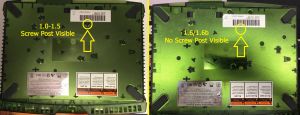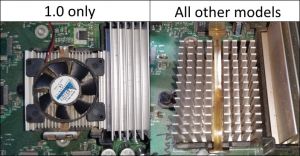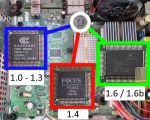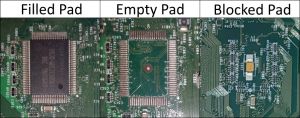Versions
Over the years in which it was produced, Microsoft introduced a number of variations to the original Xbox design. There are three retail Xbox PCB versions: A38727-009 (original versions, no codename), A38727-012 (codenamed Xblade), and X01063-121 (codenamed Tuscany). These versions are how the design revisions were referred to within Microsoft. Although there were only three official versions, PCBs were released with the same version number but different components or other changes, so the modding community named more than three versions. Modders took to opening the systems, noting the changes to the motherboards, and assigning their own unofficial version codes. Eventually enough data was gathered that it became possible to guess at a console's revision simply by reviewing its manufacturing date or serial number.
The final list of consumer systems came out as follows:
- 1.0: Initial consumer release. Notable features include the Conexant video encoder chip, and a 1MB TSOP.
- 1.1: First revision. USB Controller daughterboard removed, GPU fan and sink replaced with a singular more efficient sink, MCPX version changed from 1.0 to 1.1.
- 1.2: Motherboard power connector and PCB layout changed. PCB Part number was changed to A38727-012. Original XGPU was changed to the XGPU-S. TSOP pared down to 256KB.
- 1.3: LFRAME disconnected from pin 3 of the LPC, hindering older modchip designs.
- 1.4: Video encoder changed from Conexant to Focus. More robust gold colored clock caps started to appear in these units.
- "1.5": Supposedly identical to 1.4s, but with pins 2 and possibly also 9 disconnected from the LPC. Since their first mention around 2004, no such boards have actually been confirmed. The reports are now thought to've been in error, and likely no systems were ever manufactured according to this spec.
- 1.6: No more black clock caps. PCB was vastly redesigned and given a new part number of X01063-121. TSOP removed; BIOS and SMC shifted to a read-only Xyclops chip. New Xcalibur video encoder, which replaced the previous Focus video encoder from the previous motherboards. The 1.6's video encoder also prevented some games from running correctly in HD due to a bug in the BIOS. Empty RAM pads were removed. XGPU-S was replaced with XGPU-B, which also had a power efficiency increase. Various additional pins disconnected from the LPC, further hindering modchip installation. Power supply connector is the same shape as the "Xblade" motheboards, but rewired.
- 1.6b: Moved from Samsung to Hynix brand RAM chips; using different timings.
A great variety of limited-run Special Edition consoles were also produced. Although they almost all use motherboards of the types listed above, some of the cases are considered remarkably more valuable than those of the traditional black design.
Feature Review
There are a number of differences to consider when determining which Xbox revision you might wish to purchase, or which modding projects you might like to perform on your existing console. With the exception of 1.6/1.6b consoles (which have difficulties running some titles in HD - these can largely be cleared up by modding), all systems have the same performance when running regular Xbox games.
| 1.0 | 1.1 | 1.2 | 1.3 | 1.4 | 1.6 / 1.6b | ||
|---|---|---|---|---|---|---|---|
| Clock Cap | Leaky | Leaky | Leaky | Leaky | Leaky | Less leaky | |
| GPU Sink | Fan | Enlarged | Enlarged | Enlarged | Enlarged | Enlarged | |
| 480p Compatibility | Ok | Ok | Ok | Ok | Ok | Partial | |
| LPC | Intact | Intact | Intact | No LFRAME | No LFRAME | Needs Rebuild | |
| Upgradable RAM | Yes | Yes | Yes | Yes | Yes | Yes | |
| TSOP | 1MB | 1MB | 256KB | 256KB | 256KB | No | |
| Possible DVD Drives |
Thomson | ✓ | ✓ | ✓ | ✓ | ✓ | ✗ |
| Philips | ✗ | ✓ | ✓ | ✓ | ✓ | ✓ | |
| Samsung | ✓ | ✓ | ✓ | ✓ | ✓ | ✓ | |
| Hitachi | ✗ | ✗ | ✗ | ✗ | ✗ | ✓ | |
| Possible HDDs |
Seagate (thick) | ✓ | ✓ | ✓ | ✗ | ✗ | ✗ |
| Seagate (slim) | ✓ | ✓ | ✓ | ✓ | ✓ | ✓ | |
| Western Digital (8GB) | ✓ | ✓ | ✓ | ✓ | ✓ | ✓ | |
Clock Cap
Xboxes make use of a super cap to track the time while disconnected from a mains power source. These caps are prone to leaking, spreading a strongly alkaline (high pH) fluid that can degrade nearby electrical traces over time: although pre-1.6 models will still run correctly if they're simply removed. 1.6 consoles use capacitors of a different capacitor model that's less prone to leaking destructively, but such systems can't boot at all if their caps do fail. Anyone who owns or is considering ownership of any original Xbox model should read these notes on the issue.
GPU Sink
1.0 consoles have an additional cooling fan installed over their GPUs. Later models had this removed in favour of a slightly more efficient heatsink block, and will generally run quieter. For those concerned about noise, upgraded sinks can be installed into 1.0 units, leaving their extra fan header pins free.
480p Compatibility
Some Xbox games are capable of running in alternate display modes, with 480p being the common limit. Due to a change in video encoder chips, however, 1.6 models fail to load or display some games in 480p correctly, forcing users to set their systems to an interlaced display mode instead. Modded consoles can make use of unofficial patches to correct this issue in most of the affected titles.
LPC
The LPC (Low Pin Count) port is a location on the Xbox motherboard that brings together a variety of useful traces. 1.3 and 1.4 consoles have their LFRAME disconnected, although it can be reconnected if MCPX access is desired. Although the loss of LFRAME is mostly only an issue to those wishing to fit severely antiquated modchips into their systems (modern modchips don't make use of it), 1.6 consoles furthermore have a number of other points disconnected, and hardmodding such systems does require additional wiring to be installed.
Upgradable RAM
Consumer model Xboxes shipped with 64MB of RAM, but earlier revisions still kept the extra motherboard pads used in developer model consoles, thus allowing them to be upgraded to 128MB. 1.6 consoles had these pads removed, further complicating the effort.
The upgrade has little effect on retail games, but does improve stability for prototypes and certain homebrew applications (most notably emulators). Some such programs simply won't run on the base 64MB. HD patched games may also become more stable if more RAM is available.
TSOP
Most Xboxes load their firmware from a TSOP (Thin Small Outline Package) chip on their motherboard. While custom firmware can be used by overriding the original chip with a modchip, it's alternatively possible to softmod a system and then reflash a new BIOS directly into the TSOP, hardmodding it without needing to purchase or wire in any additional hardware. 1.6 consoles lack TSOPs, and instead keep their firmware in an alternate read-only Xyclops chip: the only way to hardmod them is with a modchip.[1] Note that softmods are available for all consumer Xbox models.
DVD Drives
To some degree, it's possible to guess which DVD drive and Xbox will come with according to the system version. Thomsons are generally more likely to have laser issues than other models, while Samsungs commonly require belt replacements to resolve ejection issues. Hitachis are quite rare, only appearing in 1.6 / 1.6b consoles.
If it's possible to eject the DVD tray prior to purchasing a unit, then the make of the drive can be determined by inspecting the shaped plastic.
HDDs
Stock Xbox hard disk drives generally fall into two categories: those which are 8GB, and those which are 10GB. In an unmodded system, this distinction is irrelevant;[2] in all models, only 8GB of storage is actually accessible.
However, a modded console with a 10GB drive (more likely to appear in later Xboxes) may have the "extra" space assigned as an additional F partition, approximately 2GB in size. Regardless as to the capacity of the stock drive, however, all Xboxes can be upgraded to use much larger hard drives.
Identification
Case Inspection
A distinction between earlier consoles and the final 1.6/1.6b revisions can be made by the design of the AV ports: a segment of metal shielding is exposed along the bottom of a 1.6/1.6b socket.
Translucent Special Edition cases may also reveal an additional screw post that's only present in earlier models.
Kernel Version
You can check your kernel version using the official Microsoft dashboard by selecting Settings → System Info. A wall of text will appear, scrolling down to reveal a "K" value representing the kernel release (Microsoft BIOS version), and "D" value representing the official dash version (Microsoft menu software).
These kernels are thought to only appear in these systems:
| Xbox Revision | 1.0 | 1.1 | 1.2 - 1.4 | 1.6 / 1.6b | ||||||
|---|---|---|---|---|---|---|---|---|---|---|
| Kernel Versions | 3944 | 4034 | 4036 | 4627 | 4817 | 4972 | 5101 | 5530 | 5713 | 5838 |
Dashboard Report
Some homebrew apps and dashboards available to modded consoles have the ability to guess which version your Xbox is. Accuracy is highly variable, although these reports are usually "good enough" to at least be sure whether you have a 1.6 system or not.
- UnleashX: Press Y on the main menu, or navigate to System → Settings → System → Xbox Info, it is listed under "Version".
- EvolutionX: It shows your Xbox version in the bottom left corner.
Manufacture Date
The MFG. DATE printed on the bottom of an Xbox can be used to make an estimate as to which model you might be looking at. Note the ISO 8601 standard YYYY-MM-DD format, and that the production dates of most models overlapped. Refurbished systems may have alternate motherboard revisions installed, regardless as to their labelled production dates, and the same is very much true of Special Edition consoles.
| Version | Date Range | |||||||||||||
|---|---|---|---|---|---|---|---|---|---|---|---|---|---|---|
| 1.0 | 2001-01 | 2002-10 | ||||||||||||
| 1.1 | 2002-08-18 | 2003-01-25 | ||||||||||||
| 1.2 | 2002-12-01 | 2003-03-15 | ||||||||||||
| 1.3 | 2003-03-02 | 2003-07-26 | ||||||||||||
| 1.4 | 2003-07-20 | 2004-04-10 | ||||||||||||
| 1.6 | 2004-03-14 | 2004-06-09 | ||||||||||||
| 1.6b | 2004-09-13 | 2005-08 | ||||||||||||
Serial Number
The serial number is printed on the label on the bottom of the Xbox, and may provide a somewhat more accurate idea of a system's version than the production date alone. It is also shown in the connection test in the stock dashboard as "S/N". Note that Special Edition consoles generally cannot have their versions identified in this manner.
Each Xbox serial code is in the following format:
LNNNNNN YWWFF
- L is the number of the production line within the factory.
- NNNNNN is the number of the Xbox produced during the work week.
- Y is the last digit of the production year.
- WW is the number of the week within the production year.
- FF is the code of the factory where the Xbox was manufactured.
First check the last two digits for the factory code. If this is 03 (from Hungary), then you're done: the unit is a 1.0 console, and shipped with a Thomson DVD drive. 02 (Mexican) units can likewise be identified as either 1.0s or 1.1s depending on whether their manufacturing date precedes November 2002 or not. Other factory codes aren't so helpful, but you can be sure they won't be 1.0s.
| Factory | Location | Xbox Revision |
|---|---|---|
| 02 | Mexico | 1.0 (pre-Nov 2002) or 1.1 (Nov 2002 onwards) |
| 03 | Hungary | 1.0 |
| 05 | China | 1.1 (or later) |
| 06 | Taiwan | 1.2 (or later) |
If you don't already have a positive ID, next take the line number (L, first digit), as well as the year & week of manufacture (YWW, first three digits of the second block). Use your L code to confirm your column, and then scroll down to your Y WW row:
| Y WW | Line 1 | Line 2 | Line 3 | Line 4 | Line 5 | Line 6 |
|---|---|---|---|---|---|---|
| 2 42 | 1.1 | 1.1 | 1.1 | 1.1 | 1.1 | 1.1 |
| 2 43 | ||||||
| 2 44 | ||||||
| 2 45 | 13 Nov | |||||
| 2 46 | ? | |||||
| 2 47 | 20 Nov | |||||
| 2 48 | ? | |||||
| 2 49 | 03 Dec | 03 Dec | ||||
| 2 50 | 1.2 | 1.2 | 13 Dec | |||
| 2 51 | 19 Dec | ? | ||||
| 2 52 | ? | |||||
| 3 01 | ||||||
| 3 02 | ||||||
| 3 03 | ||||||
| 3 04 | 24 Jan | 22 Jan | 20 Jan | |||
| 3 05 | ? | 1.2 | ? | |||
| 3 06 | ||||||
| 3 07 | ||||||
| 3 08 | 21 Feb | 19 Feb | ||||
| 3 09 | ? | 27 Feb | ? | |||
| 3 10 | 03 Mar | ? | ||||
| 3 11 | 1.3 | 10 Mar | 11 Mar | |||
| 3 12 | 1.3 | ? | ||||
| 3 13 | ||||||
| 3 14 | 02 Apr | 03 Apr | ||||
| 3 15 | 09 Apr | 1.3 | 1.3 | |||
| 3 16 | 1.3 | |||||
| 3 17 | ||||||
| 3 18 | ||||||
| 3 19 | 04 May | |||||
| 3 20 | 1.3 | |||||
| . . . | ||||||
| 3 28 | ? | |||||
| 3 29 | ? | 17 Jul | ? | ? | ? | |
| 3 30 | 23 Jul | 23 Jul | 24 Jul | 23 Jul | 23 Jul | |
| 3 31 | 28 Jul | ? | 1.4 | 1.4 | 1.4 | 1.4 |
| 3 32 | 1.4 | 1.4 | ||||
| . . . | ||||||
| 4 10 | 02 Mar | |||||
| 4 11 | 11 Mar | ? | ? | |||
| 4 12 | ? | 18 Mar | 22 Mar | |||
| 4 13 | 28 Mar | ? | 1.6 | |||
| 4 14 | 1.6 | 01 Apr | ||||
| 4 15 | 05 Apr | 10 Apr | 1.6 | |||
| 4 16 | ? | ? | ||||
| 4 17 | ||||||
| 4 18 | ||||||
| Anything beyond is likely a 1.6/1.6b. | ||||||
The above is based upon the progress made at the (now sadly defunct) Xbox Linux wiki. If your Y WW code is missing from the list, or leads to a ?, confirm your Xbox revision with a motherboard inspection instead. Please then add your version, MFG date, & serial data to this article's talk page.
Serial data for 1.6 systems (with Samsung RAM) and 1.6b systems (with Hynix RAM) is especially desirable. Whether such systems are already in the table or not, info as to which 1.4 serials shipped alongside black or gold colored clock caps is also wanted.
Motherboard Inspection
The most reliable way to identify an Xbox's model is to inspect its motherboard directly.
The official PCB version markings are found on the underside of the motherboard. For 012 and 121 the revision is marked next to the IDE header, and for 009 the revision is marked on the bottom right corner. The PCB version 009 is found in 1.0-1.1 Xboxes, 012 is found in 1.2-1.5 Xboxes, and 121 is found in 1.6 Xboxes.
1.0 systems uniquely use a dedicated GPU cooling fan. All subsequent designs had this removed, instead favouring a larger heatsink in its place. Note that some units may also've had their GPU fans switched out by a previous owner, in an attempt to reduce noise: in such cases, a 1.0 can still be readily identified by its controller daughterboard, an upright-standing circuit located at the front of the motherboard.
1.1 motherboards use the same power connector as 1.0s, but lack the controller daughterboard. If the power connector has two rows of pins, then the system must instead be a later model.
1.2 and 1.3 boards alone have a two row power connector and a Conexant video encoder chip. However, the trace connecting pin three of the LPC to the MCPX, known as LFRAME, was disconnected within 1.3 and later boards. This break cannot be located visually, making 1.2s and 1.3s difficult to confirm: it'll generally only be discovered if one attempts to install a severely antiquated modchip. Most all modern mods do not make use of LFRAME, leaving the distinction largely irrelevant.
1.4 motherboards uniquely use Focus video encoder chips, while earlier revisions have Conexants.
1.5 boards are considered to be the same as 1.4s, but with pins 2 and possibly also 9 disconnected from the LPC. They were first reported around 2003-2004, but never confirmed; it's thought that the modders in concern may've mismeasured their traces (certainly many others have since!). No pictures exist, no manufacturing dates are known, and no serials are listed. By the time it became obvious that no such boards would ever appear, modders had already come to refer to the next model as the 1.6, leaving 1.5 as a "skipped number" - the revision that never was.
1.6 boards are most easily spotted by their RAM pads. Consumer Xbox motherboards all shipped with four 16MB chips - two on the top, two on the bottom. Models prior to the 1.6 also have four empty pads where additional chips can be installed, whereas late model consoles have their expansion pads blocked off instead. If the RAM chips your console does have are Hynix branded (as opposed to Samsung), then you more specifically have a 1.6b machine. The Xcaliburs used by all 1.6 / 1.6b systems have difficulties rendering some games in 480p.
- ↑ As the southbridge was unchanged, and this design feature takes advantage of its TSOP/LPC boot order, 1.6 motherboards are effectively pre-chipped! As the additional bootrom would then conflict, this does have repercussions on modchip design and installation (leading to the LFRAME affair).
- ↑ The stock kernels do not support the unofficial XBpartitioner header, and therefore only use their hardcoded partition table.







